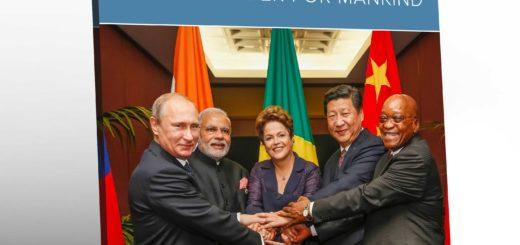EDITORIAL
Has Obama Left ‘a New Great Recession’ for Trump?
Dec. 8 (EIRNS)—While the decisive current question is whether the incoming Trump Administration will truly bury the “regime-change war doctrine” and pursue productive economic cooperation with China and Russia, there were reminders today of Barack Obama’s other sad legacy, the economy. The U.S. Council on Competitiveness released a report on U.S. productivity titled “No Recovery,” and aptly headlined in USA Today, “The Obama Recovery Wasn’t a Recovery After All.” And the National Center for Health Statistics issued a grimmer study, finding that life expectancies for the entire U.S. population are actually falling, and death rates from almost all the most common diseases rising, along with infant mortality. One study researcher said, “There’s just this across-the-board phenomenon of not doing very well in the United States.”
Despite the brief “market” euphoria over Trump’s election, many economists are forecasting that Obama has left him “a new Great Recession”; and in fact, an early financial crash, due to the manifest incapacity of the Dodd-Frank Act to control and subdue Wall Street. Many of the most active and concerned Americans are deeply worried about this as well.
The “biggest question” named above will, fundamentally, decide it; American prosperity will return by cooperation in the “New Silk Road” of great infrastructure building, by cooperation in Moon, Mars and deep space exploration; by cooperative breakthroughs in fusion power technologies, nuclear desalination and power.
As the LaRouche PAC Policy Committee’s Rachel Brinkley put it in a statement on the failed Dodd-Frank Act, “First, is the … increase of real wealth resulting from increased rates of physical productivity. China’s New Silk Road policy is positively affecting 70 countries and 4.4 billion people, through focusing on the construction of new transportation routes and energy development, including the building of high-speed rail and more efficient ports, electrifying rural regions, and partnering in advanced scientific cooperation with other countries. This is a current, living demonstration of how to positively affect net rates of physical growth. Monetary processes must always be subordinate to this….”
But we must have a Glass-Steagall reorganization of the banks immediately—otherwise, with rising interest rates now hitting huge new bubbles of debt, Wall Street and London will crash again and destroy the prospects of progress. Trump has said he wants Glass-Steagall reinstated; many well-known economists say Congress and his Wall Street advisors will not allow it.
They underestimate the pent-up demand among millions of informed Americans to have Glass-Steagall justice and “close down the Wall Street casino.” Then a Franklin Roosevelt-style national credit and productivity policy can lift the nation out of the long economic collapse in which Bush and Obama have left it.
COLLAPSING WESTERN FINANCIAL SYSTEM
More Bad U.S. Demographics News: Lifespans Falling
Dec. 8 (EIRNS)—Another report has shown the demographic effects of economic devastation in the United States’ past 15 years under Presidents Bush and Obama.
The National Center for Health Statistics (part of the Department of Health and Human Services) reported Dec. 7 that death rates rose across the whole American population in 2015 (relative to 2014, and to 1999) for 8 of the 10 most common diseases.
A drumbeat of scholarly reports and data analyses published over a year and a half, have shown the unprecedented appearance of a rising death rate among the white population of working age. Now the whole population is encompassed in this rise. “This is singular. This doesn’t happen,” commented Dr. Ann Case of Princeton, co-author of the first such shocking study, in September 2015.
The new study’s lead author, CDC epidemiologist Jiaquan Xu, told the Washington Post Dec. 8, “This is unusual and we don’t know what happened. So many leading causes of death increased.”
Moreover, the HHS study finds the American population’s overall lifespan starting to fall. Male life expectancy at birth fell to 76.3 years in 2015 from 76.5 in 2014; female life expectancy from 81.3 to 81.2. Infant mortality rose “slightly.” Only two months ago, the American Society of Actuaries projected such drops statistically, based on increasingly pessimistic assumptions actuaries are making about death rates. In that Oct. 28 report, the Actuaries said, “If Americans’ health continues to decline, the assumptions in this report will still prove too optimistic.” At that time, they were still assuming an overall death rate falling (though extremely slowly) among all Americans. But that rate is now rising.
“This is a big deal,” said Philip Morgan, a demographer at the University of North Carolina.” There’s not a better indicator of well-being than life expectancy.” Another researcher, University of Michigan’s David Weir, commented, “There’s just this across-the-board phenomenon of not doing very well in the United States.”
A sad illustration of the economic devastation underlying this dramatic change, is the New York Times’ report today of a “continuing surge in the homeless population” in New York, resulting in 5,800 hundred family members being put into rented rooms by the city because homeless shelters are full; only 1,237 people were in such rented rooms on Jan. 1, 2016. The city today is mourning the deaths of two toddlers killed by scalding water when a radiator burst in one of those rented rooms.
U.S. Competitiveness Council: There Was No ‘Obama Recovery’
Dec. 8 (EIRNS)—The U.S. Council on Competitiveness (USCC) and the Gallup Organization have published an economists’ study, entitled, “No Recovery: An Analysis of U.S. Long-Term Productivity Decline.” As USA Today aptly headlined its coverage of the report: “Maybe the Obama Recovery Wasn’t a Recovery After All.”
Specifically the USCC study concluded that for the past 15 years, per-capita GDP in the American economy has grown at an annualized rate of just 1%, and that it is growing at just half that rate since the 2008 financial crash.
In addition, U.S. multi-factor productivity has grown at a very low 0.4% annualized rate over the past decade. Multi-factor productivity attempts to measure the efficiency with which factories or other productive facilities use additional labor and additional capital investment; it is an approximation of the lift to the economy of invention and technological progress. This measure’s contribution to U.S. productivity growth was at 3.0-3.5% annually during the years from FDR’s to JFK’s presidencies; the 0.4% of the Obama years (and several years of the George W. Bush Administration) is a far cry from that.
The USCC report also finds that, “Exports as a share of GDP increased from 11.5% in 2007 to 12.6% in 2015,” even though globally, growth was slowing down. Thus, the global slowdown was not what was dragging the U.S. economy; rather, a lack of real economic demand in the U.S. economy itself is indicated. Demand for private investment has fallen, and business capital investment has fallen, they imply, as a result.
The report quotes Yale economist and author Robert Gordon that, “the quality of inventions has fallen.” “Gordon argues that advances [inventions, new technologies] since 1970 have tended to be channeled into a narrow sphere of human activity having to do with entertainment, communications, and the collection and processing of information,” the report says. “For the rest of what humans care about—food, clothing, shelter, transportation, health, and working conditions both inside and outside the home—progress slowed down after 1970.”
Thus, the introduction notes, “There is a pervasive sense that the economy is not working, as documented in Gallup survey data and many anecdotal media accounts.”
U.S. POLITICAL AND ECONOMIC
Environmentalists, Drug Pushers Oppose Trump’s EPA Nominee
Dec. 8 (EIRNS)—The nomination of Oklahoma Attorney General Scott Pruitt to head the Environmental Protection Agency (EPA) has produced the outrage you would expect from the places you would expect it. As Trump has pointed out, the rulings of the EPA and its enforcement of those rules—which are, in fact, based not on science but on ideology—have savaged whole sectors of the U.S. economy. Scott Pruitt has filed two dozen lawsuits against the EPA and led the fight waged by states’ attorneys general against dictates such as the Clean Power Plan, which “fights” supposed global warming by shutting down whole sections of the economy. Pruitt’s oil and gas state is one of those on the front lines.
“This is looking really bad,” said Ethan Nadelmann, a George Soros operative who is executive director of the Drug Policy Alliance, in a press release about Trump’s cabinet picks. “First, Sessions for Attorney General, then Price at HHS, and now yet another old-style drug war character for Homeland Security. It looks like Donald Trump is revving up to re-launch the failed drug war,” Nadelmann told Business Insider. Environmental extremist Bill McKibben, writes in the New York Daily News that more than just “a mouthpiece and a puppet of the fossil fuel industry,” he is “a stenographer.”
Coming from an oil and gas state himself, Pruitt’s focus will be getting rid of the environmental constraints on those resources and one would assume, coal, since Trump made promises to coal miners during the campaign.
Trump Foreign Policy Advisor in Moscow
Dec. 8 (EIRNS)—Carter Page, reputedly a foreign policy advisor to President-elect Donald Trump, is in Moscow. Page, who has been very outspoken in his support for improving relations with Russia, told Sputnik he was planning to meet with businessmen and “thought leaders.”
Russian Deputy Foreign Minister Sergey Ryabko told reporters, “No, I have no comments on this. As of this morning, there are no plans to hold meetings in the Foreign Ministry.”
A graduate of the U.S. Naval Academy and a former intelligence officer who has gone into the oil consultancy business, Page has considerable experience dealing with Gazprom when he worked in Moscow in the past. Page founded his own investment fund, Global Energy Capital, in 2008; his other partner is former Gazprom executive Sergei Yatsenko.
Speaking to Sputnik in October, Page said that “many of America’s core national interests overlap significantly with the strategic priorities of Russia. But unfortunately, an arrogant foreign policy in Washington has quite often failed to consider America’s own fundamental priorities.”
Page said, “Russia without question could have significantly contributed to better outcomes if a genuine relationship based on mutual respect had been effectively forged.” He noted that Russia and the United States could join forces in fighting Islamic extremism, de-escalating the situation in Ukraine, and working inside potential conflict zones in Asia.
THE NEW GLOBAL ECONOMIC ORDER
African Leaders Instruct Germany on the New Paradigm at Fourth Yearly Infrastructure Forum
Dec. 8 (EIRNS)—In opening the fourth German-African Infrastructure Forum in Hamburg on Dec. 5-6, the CEO of the Afrika-Verein der Deutschen Wirtschaft, or German-African Business Association, Dr. Christoph Kannengießer, referred to a recent headline from Die Zeit, “Federal German Government Discovers Africa.” For those of us involved in Africa already, he said, we might find this ironic. However, there is some truth to it, he conceded.
What became evident during the first day of the conference is that the Africa that German businesses think they know, is undergoing the same paradigm change occurring in the rest of the world. Many of the speakers from Africa expressed deep concern that their “partners” in the room are unaware of those changes.
This was expressed most clearly by Christian Eddy Avellin, the director of the Toamasina Port Authority for the main port in Madagascar. “The world is changing,” he said. “China and India are emerging. Japan is keeping its place in the world. Over the last 25 years, you in Europe should have thought more about Africa…. The reality is that the world economy is shifting to Asia. China is trading with Africa and South America. You must look at South-South relations.” He concluded this part of his presentation, that “Europe will be marginalized unless it recognizes this and becomes involved.”
His comments prompted a barrage of criticism, including complaints about, for example, the high interest rates charged by European banks; the conditionalities imposed as a prerequisite for loans; and arrogance—which was typified by the moderator, who kept asking about private partnerships, stressing the need for privatization, and criticizing the quality of Chinese goods and technology.
“If you want to come, you are welcome, but don’t tell us what to do” said Ali Guelleh Aboubaker, an advisor to the President of Djibouti in charge of investments.
A representative of EIR and Lyndon LaRouche intervened: “Let’s be clear about what is being said. There is a new paradigm in existence.” Describing the BRICS and Asian Infrastructure Investment Bank (AIIB), the New Silk Road, the Chinese scientific orientation, he said, “This is the future. At the same time, the revolt is accelerating in the trans-Atlantic region, with the Brexit vote, and Trump’s victory.”
EIR’s remarks triggered further statements from African officials. The head of a small business association from Congo said, “While you Germans are complaining, we are waiting for investment. We have had years of war, of looting. Everything must be built. We need infrastructure. Our Western partners want privileged partnerships, but that is no longer possible.”
Avellin reiterated, “The world is changing; we no longer will accept dictatorship from the IMF or World Bank.” He said, “The Chinese are there, they are helping.” He was backed up by a representative of the Namibian government, who said that there is something new in southern Africa, cooperation between nations, not competition.
Two Planned Bangladesh Nuclear Plants Get Russian Backing
Dec. 8 (EIRNS)—The Daily Star of Bangladesh reported on Dec. 7 that Bangladesh’s Executive Committee of the National Economic Council approved the construction of the two Russia-supplied VVER 1200 MW nuclear power plants. The groundwork for the construction of the plant, named the Rooppur Nuclear Power Plant, is now under way in the northern Bangladesh town of Ishwardi. According to the Dhaka Tribune, Russia is expected to provide $11.2 billion for the project while the Bangladesh government will provide $2.7 billion.
The foundation stone for the plant was laid in October 2013. Inaugurating the ceremony, Bangladesh’s Prime Minister Sheikh Hasina Wazed had said: “I believe it fulfills the nation’s dream. After decades of speculation, plans and programs, commissioning of Rooppur Nuclear Power Plant is going to be a reality heralding a new era for Bangladesh. This is indeed a joyful day for the countrymen.”
In January 2013, Russia agreed to provide a $500 million loan to Bangladesh to help finance engineering surveys on the site, for project development, and to provide personnel training. Once operational, the project is likely to provide 10% of the country’s total power and help achieve the government’s projected target of 20,000 MW power capacity by 2021. It will be connected to the grid through the sub-station at Ishwardi, located 4 km from Rooppur. The power plant is expected to have an operational life of 60 years and can be extended for another 20 years, reported the Daily Star.
Three Nations Build Nuclear Fuel Assembly Plant in Kazakhstan
Dec. 8 (EIRNS)—Construction of a nuclear fuel fabrication plant, brought about by a joint venture between Areva of France, National Atomic Company of Kazakhstan (Kazatomprom), and China General Nuclear Power Corp. (CGNPC), has begun, World Nuclear News(WNN) reported today. It may allow Kazatomprom to supply up to one-third of world nuclear fuel fabrication by 2030, WNN wrote. Kazakhstan is currently the world’s leading uranium producer, accounting for 39% of output in 2015.
“Construction of the Fuel Assembly (FA) Manufacturing Plant is one of the breakthrough projects to be implemented under Kazatomprom’s strategy, which focuses on the development of a vertically integrated fuel cycle company with advanced nuclear fuel fabrication capabilities,” Kazatomprom reported on Dec. 6
France’s Areva will provide the FA production technology. Upon completion, the plant will be managed through Ulba-FA, a joint venture of Kazatomprom subsidiary Ulba Metallurgical Plant (UMP) (51%), and CGNPC subsidiary CGN-URC (49%).
World Nuclear News reports Kazatomprom CEO Askar Zhumagaliyev pointing out that the plant was the result of long-term cooperation between Kazakhstan, China and France and was a strategic step by Kazatomprom towards production diversification. “Maintaining our uranium mining leadership, we are planning to offer to the market, fuel for nuclear power plants of Kazakh origin, which will allow us to strengthen our position on the global nuclear market,” he told WNN. CGNPC Director General Zhang Shanming also said, according to WNN that “The project allows CGNPC and Kazatomprom to take their cooperation to a ‘new level.’ ”
UMP’s plant already has the capability to manufacture 2,000 tons/year of fuel pellets. Kazakhstan, with China and France’s help, is clearly preparing for a worldwide surge in nuclear power production which can already be seen coming.
STRATEGIC WAR DANGER
Syrian Army Suspends Combat Operations in Aleppo To Allow Civilian Withdrawals, Says Lavrov
Dec. 8 (EIRNS)—Russian Foreign Minister Sergey Lavrov said today that the Syrian Army has suspended combat operations, “as a yet another—and the biggest one so far—operation to evacuate the civilians willing to leave the place, is underway there,” reported TASS. “There are some 8,000 people in the column. That’s a huge operation and the withdrawal route is 5 km long.”
Lavrov, in Hamburg, Germany for the Organization for Security and Cooperation in Europe (OSCE) foreign ministers meeting, also reported that he had had a telephone conversation and two short meetings with U.S. Secretary of State John Kerry in Hamburg. “An agreement was reached to organize a meeting between military experts and diplomats in Geneva on Saturday,” he said, to work on the withdrawal of militants from the few neighborhoods that they still control.
“As for Jabhat al-Nusra, the United States is seeking to spare it. Moreover, during all our talks, the Americans tried to word agreements in such a way that would leave al-Nusra out and deliver it from reprisals,” Lavrov said. “Naturally, we cannot accept that. Al-Nusra is a terrorist organization, recognized as such by the United Nations, the United States, Russia and other countries. It sets one thinking.”
Philippines: U.S. May Not Use Our Bases for ‘Freedom of Navigation’ Provocations
Dec. 8 (EIRNS)—Philippine Defense Secretary Delfin Lorenzana, just returned from a visit to Russia to discuss military cooperation, was asked in a press conference today if the Philippines will continue to allow U.S. ships and aircraft to conduct their “Freedom of Navigation” provocations in the South China Sea from bases in the Philippines, as they have in the past. Lorenzana said that President Duterte will refuse in order “to avoid any provocative actions that can escalate tensions in the South China Sea. It’s unlikely,” AP reports. “Anyway, the U.S. can fly over there coming from other bases,” referring to Guam, Okinawa, and U.S. aircraft carriers.
The number of joint military exercises have been reduced and will focus on disaster-response and humanitarian missions rather than exercises aimed at confrontation with China, the government announced last month. AP whines that, “Duterte’s actions have become a hindrance to U.S. efforts to reassert its presence in Asia, although the U.S. military has vowed to continue patrolling one of the world’s busiest commercial waterways.”
General Lorenzana also told the press that both Philippine fishing boats and coast guard vessels are now freely sailing in the Scarborough Shoal area, which China had blocked since a confrontation in 2012, and China is also not blocking re-supply of the ship that the Philippines intentionally grounded on another contested shoal.
SCIENCE AND INFRASTRUCTURE
China Pushes Ahead Toward Its Fusion Energy Test Reactor
Dec. 8 (EIRNS)—The progress Chinese fusion scientists are making in experiments in their EAST (Experimental Advanced Superconducting Tokamak) reactor in Hefei has reinforced their confidence to proceed in the design of their next-step Chinese Fusion Engineering Test Reactor (CFETR), scheduled to come online in 2025. Recently, EAST set a world record in a 100-second burn in a high-density hydrogen plasma. “It is a milestone event,” said Prof. Luo Guangnan, deputy director of the EAST facility, “a confidence boost for humanity to harness energy from fusion.”
The South China Morning Post today covers how China is the sole nation increasing funding for fusion, noting that the U.S. MIT Alcator shut down. “China is the only nation in the world increasing its budget for fusion research,” said Dr. Luo. “The funding in Europe has been dwindling, a proposal for the construction of new research facilities in the U.S. was rejected by Congress, and progress in Japan has also stagnated.” As a result, “In each of our experiments in recent years, the number of foreign participants easily exceeded 100,” said Luo. The article reports that Chinese fusion scientists are “leaving other nations in the dust.”
“It is hoped that the proposal for CFETR construction can be approved by the government within the next five years,” Chinese fusion pioneer, Dr. Wan Yuanxi, said at an international fusion conference last month. The Chinese Fusion Engineering Test Reactor would go into operation in 2030, generating 200 MW of electricity initially, and then be upgraded in the following decade to around a gigawatt. Although the conservative approach would be to wait and see the results of ITER’s first fusion experiments before taking the next step—ITER’s first plasma experiments are now delayed to 2025, China is not going to wait, but plans to move into the stage of engineering a reactor, confident that ITER will reach its goals.
An interview with Dr. Wan on the history and goals of China’s fusion program is in the March 11, 2011 issue of EIR.














